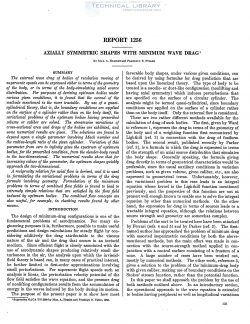naca-report-1256
- Version
- 165 Downloads
- 1.14 MB File Size
- 1 File Count
- November 2, 2016 Create Date
- November 2, 2016 Last Updated
National Advisory Committee for Aeronautics, Report - Axially Symmetric Shapes with Minimum Wave Drag

The external wave drag of bodies of revolution moving at
supersonic speeds can be expressed either in terms of the geometry
of the body, or in terms of the body-simulating axial source
distribution. For purposes of deriving optimum bodies under
various given conditions, it is found that the second of the
methods mentioned is the more tractable. By use of a quasi-
cylina'rical theory, that is, the boundary conditions are applied
on the surface of a cylinder rather than on the body itself, the
variational problems of the optimum bodies having prescribed
volume or caliber are solved. The streamun'se variations of
cross-sectional area and drags of the bodies are exhibited, and
some numerical results are given. The solutions are found to
depend upon a single parameter involving Mach number and
the radius-length ratio of the given cylinder. Variation of this
parameter from zero to infinity gives the spectrum of optimum
bodies, for the prescribed condition, from the slender-body result
to the two-dimensional. The numerical results show that for
increasing values of the parameter, the optimum shapes quickly
approach the two-dimensional.
A reciprocity relation for aaialflow is derived, and it is used
in formulating the variational problem in terms of the drag
formula involving geometry. Formulation of the minimum
problems in terms of combined flow fields is found to lead to
extremely simple relations that are satisfied by the flow field
induced by optimum bodies. The combined flow concepts are
also useful, for example, in checking results found by other
means.
The design of minimum-drag configurations is one of the
fundamental problems of aerodynamics. For many en-
gineering purposes it is, furthermore, possible to make useful
predictions and design calculations for steady flight by con-
sidering additively the drag attributable to the viscous
nature of the air and the drag that occurs in an inviscid
medium. Since efficient flight is closely associated with the
use of aerodynamic shapes producing relatively small dis-
turbances in the air, the analysis upon which the inviscid-
fluid theory is based can, in many cases of practical interest,
be further limited to first-order approximations involving
small perturbations. For supersonic flight speeds such an
analysis is linear, the perturbation velocity potential of the
flow field satisfies the wave equation, and the pressure drag
of nonlifting configurations results from the accumulation of
energy in the waves induced by the body during its motion.
| File | Action |
|---|---|
| naca-report-1256 Axially Symmetric Shapes with Minimum Wave Drag.pdf | Download |

Comment On This Post